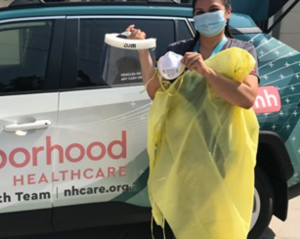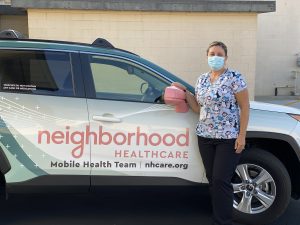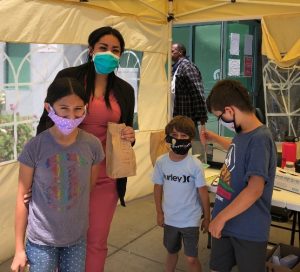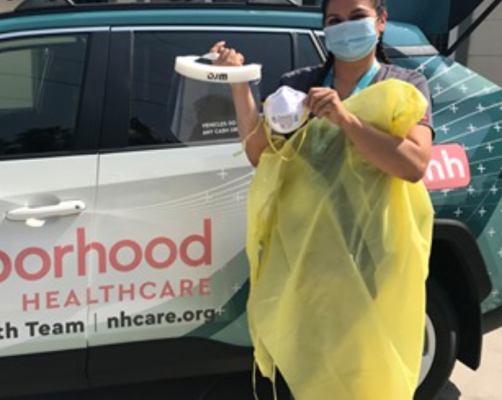In the wake of the lockdown triggered by the COVID-19 pandemic, Neighborhood Healthcare did what many health care organizations did — it quickly pivoted to telemedicine. But some of its ailing low-income patients lacked the technology or digital skills needed for virtual care, so Neighborhood Healthcare decided to bring it to them.

Neighborhood Healthcare mobile clinic worker showing the personal protective equipment she uses in her visits
The San Diego-based health center created a mobile telemedicine team that makes regular house calls to high-risk patients with three or more chronic diseases. Its purpose: To help patients stay healthy by doing their routine tests and check-ups outside the four walls of traditional health care settings. This process is known as “remote patient monitoring,” which has become a hot ticket item in telemedicine for its potential to lower health care costs, improve chronic disease management, and reduce preventable repeat trips to the emergency room.
The term “remote patient monitoring” is particularly apt in Neighborhood’s case. “We have elderly, low-income patients way out in the mountains and hills, in places so remote we joke that you expect to run across the Tiger King in someone’s back yard,” said Neighborhood Healthcare’s Chief Operating Officer Jeffrey Glenn. “It’s hard for them to get to our clinics in the first place, and since they’re at high-risk for COVID-19, they’re much better off doing this monitoring in the safety of their own homes.”
Neighborhood Healthcare belongs to an initiative known as the Connected Care Accelerator, a new CCI program with the California Health Care Foundation that is supporting telehealth innovations in 50 clinics across California. It’s just one of the many CCI efforts tackling how to support the adoption and implementation of remote patient monitoring.
Technology Hub participants, for example, are already piloting tools in this space, as are urban and rural clinics in our Colorado Health Innovation Community Catalyst (CHIC). Our participants in Preventing Heart Attacks and Strokes Everyday, also known as PHASE, are doing self-measured blood pressure monitoring, in which patients regularly measure their own blood pressure at home so that providers can better diagnose and manage hypertension. And in early 2021, CCI and partners will be launching the Virtual Care Innovation Network with Kaiser Permanente and partners, which aims to support the broader adoption of virtual care with remote patient monitoring as a key tool to manage people with chronic conditions.
“Ironically, with the pandemic, many of the restraints that kept innovation from occurring and continuing have been lifted, which has led to an explosion of innovation in telehealth and virtual care,” says CCI Senior Innovation Fellow Veenu Aulakh, who oversees the organization’s technology and innovation portfolio. She adds that after the first wave of telemedicine — an almost overnight pivot to phone and video visits – an important priority that has emerged among safety net clinics is remote monitoring for high-risk patients.
A recent Remote Patient Monitoring Innovation Challenge, which the California Health Care Foundation organized with Adaptation Health and partners, highlighted both emerging and more established patient monitoring technologies that are enabling more scalable, effective, and culturally responsive care.
Tackling inequities with a mobile clinic
Neighborhood Healthcare leaders have distributed blood pressure cuffs, glucometers, blood oxygen monitors, and other home monitoring equipment to hundreds of high-risk patients. But they realized early on that remote monitoring involved a lot more than dropping off a package of equipment on someone’s doorstep. With a low-income population less familiar with digital tools than the general population, it was not enough to give people tools to monitor their health at home – they needed help learning how to use them.

Cindy Herrera next to her Neighborhood Healthcare mobile health team van
Using CAREs Act funds and grant dollars, Neighborhood Healthcare bought three hybrid vans for $40,000 each and tricked them out with bright-colored logos, iPads, remote monitoring equipment, disinfectant and cleaning supplies, and personal protective equipment. The health hub then sent three medical assistants and a dental hygienist out to remote locations – equipped with a “panic” button in case of an emergency — to do check-ups, remote monitoring and/or set up video visits between providers and high-risk patients. “Our biggest areas of focus are diabetes, uncontrolled blood pressure, and chronic obstructive pulmonary disease (COPD),” Glenn said, noting that the mobile unit also does dental checks, pediatric well-visits, and other routine screens and lab work.
During the pandemic, the Neighborhood Healthcare mobile service team has served hundreds of vulnerable patients, with a potential reach of 8,000. Since 80 percent of the health center’s patients are Latinos, most of the patients tagged for home visits are as well. To reach Spanish speakers in San Diego County and surrounding areas, Neighborhood Healthcare did more than a dozen interviews with Spanish-language radio stations and the Spanish television powerhouse Telemundo. (See one Spanish-language TV story on the program here). The response was enthusiastic.
“In about half the cases, we’re seeing patients to do their vitals, take blood, and collect specimens, which they’d normally have to travel a really long way to the clinic to do,” Glenn said. “They’re thrilled by how convenient it is.”
The medical assistants and dental hygienist on the team are equipped with everything from COVID-19 test kits to blood oxygen monitors and a portable scale, as well as questionnaires about social needs such as rent or food. Gowning up before each visit with a new N-95 mask, gloves, gown and other protective equipment, they see many elderly and disabled patients. If the patient has agreed to a virtual care visit, they set up the session via IPad (and fix up the patients with a mask if they can’t afford one). Meanwhile, the mobile team often uncovers hidden barriers that need tackling before patients can monitor their conditions remotely — something easier to figure out in their homes than in a 15-minute office visit.
“People feel more comfortable talking with you in their home,” says Cindy Herrera, a medical assistant who is Neighborhood Healthcare’s mobile representative for all of Riverside County. She mentions an older Spanish-speaking couple, former farmworkers who don’t speak English or read and write in any language. The wife takes care of her husband, who has diabetes, Herrera said, and in her first visit, she was surprised to learn they had not seen a doctor for months. Worse, the husband was feeling disoriented and feeble, barely able to walk. Upon further questioning, Herrera learned that he was using his diabetes medicine incorrectly.
“It turns out that he was taking double the amount of medicine he was supposed to,” Herrera said. “So I got out my markers – the couple told me they could read numerals–and color-coded the medications with numbers for ‘1’ for medicine once a day and a ‘2’ for medicine to take two times a day. I also found they didn’t know how to use the glucometer at all, so I showed them,” she said, noting that she and the other mobile unit employees report the read-outs to the provider. “I also wrote down [blood glucose] numbers that were too high or too low, and told them, ‘If you see these on the glucometer, you should call us right away.’” On her next visit, two weeks later, she reports, her patient was alert and in good spirts.
Pressure drop
At a health hub in the state’s Northern Sierras, Charles Kitzman, Shasta Community Health Center’s chief informatics officer, is talking about the blood pressure cuffs his team has distributed to their high-risk patients. “We’ve mailed out 100 so far, with simple instructions that we cartooned up a bit” to make it more accessible, he says. “These folks have to take their blood pressure several times a day. “We hope to guide them to video visits where, if we witness the reading, it counts toward the managed care plan hypertension quality incentive,” says Kitzman. “But we recognize that them simply having and using the cuffs [promotes] engagement in their health and is therefore a value-add.”
“Our patients are happy we’re looking out for them,” adds Kitzman, whose Redding-based organization has long been a member of CCI and CHCF’s telemedicine initiatives. “They’re delighted that we call them and ask them to measure their blood pressure and stay in touch,” he says, citing feedback from patient satisfaction surveys. “They’re really grateful for that type of attention. They feel more empowered.”
In video visits, he says, providers can see how patients are using the cuff and what size each patient needs. “These cuffs are so easy to use – it’s not like the old days,” he says. “The big struggle is the technology and trying to connect.”
As an example, he points to some cell phone conversations providers had with a patient who needed to report his blood pressure monitoring. “The next time we called, we got his grandson,” Kitzman said. “We asked to speak to our patient, and he said, ‘Well, I’m not with grandfather right now.’ It turned out the grandfather had used his grandson’s cell phone for the initial visit because he didn’t have one of his own. Those are the kind of problems we are running into.”
But they are obstacles that Shasta is working to overcome.
“Historically we’ve done very well at managing hypertension, so the bar is set very high,” Kitzman says. “COVID has certainly been a game-changer.”
About three hours south of the Shasta health center, Chapa-De Indian Health is also distributing blood pressure cuffs to its high-risk patients. Chapa-De serves American Indians, Native Alaskans, and low-income patients from its clinics in Auburn and Grass Valley. “That initiative has just exploded since COVID,” says Chapa-De Nurse Practitioner Meagan Mulligan.
So far Chapa-De has distributed 402 blood pressure cuffs to its far-flung patients, then followed up with phone and Zoom visits to help ensure that they understand how to use them. By this August, the health hub found that blood pressure control had improved among all its patients, including all hypertension patients vs all hypertension patients monitoring from home, “but the people who have cuffs are doing even better.” And among all natives with hypertension vs. those monitoring their blood pressure from home, those with cuffs saw still higher gains. In addition, most of the patient self-monitoring reports qualified for NCQA quality improvement incentives.
“Our patients have definitely appreciated it,” Mulligan says. “Blood pressure is a silent killer, and by monitoring it at home, the disease became that much more real to them. ‘I had no idea my blood pressure was so high!’ some of them told us. It creates a powerful sense of ownership.”
Uncovering rampant hunger, fear among immigrants
Undocumented workers – many of whom put food on our table – have been left out of all federal relief or stimulus aid during the pandemic. Since losing their jobs during the pandemic, some have no source of income other than help from friends or family. Neighborhood Healthcare is serving these patients, among others, and Herrera and her colleagues do full screens to identify the full range of their needs with all clients. They have found widespread suffering.
“Some people feel desperate,” said Herrera, discussing her migrant patients. “They have no diapers, they don’t have food. I was talking to one couple and found they were fasting because they had nothing to eat in the house. They are afraid to ask for help” because of their fear of immigration agents. Herrera always carries snacks for just this scenario – small boxes of apple juice, granola bars and string cheese, along with diapers and sanitary supplies – “to get them through while I set them up with a case manager who will connect them to

Neighborhood Healthcare distributing food during COVID-19
food banks or grocery distribution, rental assistance, and whatever else they need.” Just this week she visited the house of a Spanish-speaking patient who had no food or electricity in his home. “I was able to arrange for Meals on Wheels to deliver food to him, starting that evening, and called 211 for help with the electricity, which they got turned back on the same day.”
The mobile clinic program is especially important during the pandemic, she says, because the Latino family caregivers who typically take care for elders or disabled family members have curbed their visits to shield them from COVID-19. With this in mind, Herrera views part of her job as alleviating the loneliness, isolation, and despair felt by many seniors and disabled patients.
“There’s a very nice young man who was paralyzed when someone trying to steal his car shot him in the back; he calls me his angel,” reports Herrera, who sees around 200 patients a month in the field. “He couldn’t fit his wheelchair into a cab so before the mobile unit came, he would have to take an ambulance to the doctor each time. It was such an ordeal. And I have a very sweet 90-year-old Latino man who is living by himself, and he is very grateful to have someone to talk to,” she said. “Normally his grandson comes by, but family members are worried about giving the grandfather the illness.”
Herrera recalls another patient who has a sunny outlook despite medical setbacks: “This little lady has an amputated leg from diabetes and she’s in a two-story house, but she hops up and down the stairs on the other leg and sweeps, dusts, mops, cooks – everything. She told me ‘I lost my leg but I’m not dead – I’m going to take care of myself.’” (Neighborhood Healthcare recently featured Herrera and another employee in a short video about the mobile health team and patients.)
Herrera, who has three children, a grandchild, and a husband with heart issues, brings a background in caregiving to her work. She acknowledges occasional challenges to seeing people in their home – such as one house with several pit bulls running loose in the yard, forcing her to cancel the visit – but says those issues can easily be resolved. “The man wasn’t able to catch all his dogs all in time,” she says, “but he apologized and had them all pinned up the next time I came.”
“I was born in the United States, but I was raised in Mexico, so I have the culture of the old country in my heart – that kindness and wanting to help,” she said. “I’m passionate about health care and about helping my clients; it feels like this is what I was meant to do. I love my job.”
Forecasting the post-pandemic future
COVID-19 has exposed and exacerbated our nation’s health inequities. But after the pandemic abates, our new reliance on virtual care — accompanied by big changes in reimbursement and regulations, as well increased patient and provider acceptance of telemedicine — has ushered in a new era for remote patient monitoring, which holds great promise for bridging the care gap that historically underinvested populations face.
The same solution that today is allowing clinics to safely treat large numbers of non-COVID-19 patients even during the worst waves of the pandemic may be able to treat Latino and African American adults post-pandemic who are less likely than their white counterparts to see their doctor because of barriers like inflexible hourly jobs and lack of childcare options. Remote patient monitoring could also help reach rural residents, many of whom have dismal options for public transportation.
Neighborhood Healthcare’s Jeffrey Glenn feels that for his organization, remote monitoring is opening up a new world. “It’s really good for us to get eyes into how people live,” he says. “We’re so excited about this, and our next step is to send our nurse practitioners into the field. We have 5,000 MediCal beneficiaries in Southern California who could benefit from a visit, so we are definitely planning on expanding our mobile fleet.”
Find this useful or interesting? We’re constantly sharing stuff like this. Sign up to receive our newsletter to stay in the loop.

